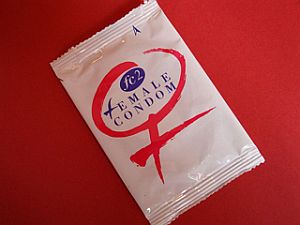CNS - Nineteen years after female condoms were approved by the US FDA in 1993, they are not yet available as widely as one would have wished. What could have delayed their optimal utilization to meet the unmet prevention needs: was it because female condoms were not rolled out under a robust enough and well-resourced comprehensive programme and strategy, or potential users didn't prefer using it?
XIX International AIDS Conference (AIDS 2012) delegates voted for female condoms sending a clear message that female condom introduction must be supported by strong, well-resourced and strategic scale up programmes in countries and communities where unmet need is acute.
Carol Nawina Nyirenda, from Zambia CITAM Plus, has been living with HIV for several years. She shared her perspective about using the female condom. It makes her "feel sexy" and she can wear it even five hours before sex, she said. Alice Welbourn, from the UK Salamander trust, also living with HIV, discussed the problems with availability, access and affordability of female condoms. Alice remarked to Citizen News Service that she is now buying the female condom online, as it became unavailable at her local store.
The female condom is the only available female-initiated method that provides multiple protection against a range of sexually transmitted infections (STIs) including HIV, and unintended pregnancies. It also provides bi-directional protection to both partners who engage in the coital act. However, many women and men who are in urgent need of HIV prevention methods and want to use female condoms are unable to access them.
Currently, millions of women do not have access to affordable contraceptives and other protective measures for STIs such as HIV. Female condoms are a cost-effective and lifesaving tools, yet they represent only one percent of all condoms distributed worldwide.
At AIDS 2012, the Paper Dolls campaign by Universal Access to Female Condoms, Center for Health and Gender Equity, the AIDS Foundation of Chicago and other partners highlighted the fact that many women and men around the world are calling for increased access to female condoms as a preferred form of dual protection.
Paper dolls have been dotted around the conference and were strung together on Friday, the final day of AIDS 2012. The dolls had colourful messages collected from individuals around the globe, each one testifying to the value of the female condom as protection against HIV infection and to plan children. Campaign organisers say they hoped to break the Guinness World Record for the longest chain of paper dolls.
The female condom gives more power to women to negotiate safer sex, chose to use a prevention option, and thus empowers them. It is easier to negotiate the use of a female condom as it can be inserted before sex. The female condom can enhance sexual pleasure and feels more natural. It is suitable for all women and can be used during menstruation, pregnancy and after giving birth.
Female condoms are also a protection option during anal sex and this use deserves more awareness among all target groups, including men who have sex with men, who are considered at high risk for becoming infected with HIV, or for transmitting it.
Advocates have proclaimed September 12, 2012 to be the first ever Global Female Condom Day. Individuals and organizations across the world will join together on this dedicated day of action to demonstrate global demand for this highly effective safer sex tool.
If female condoms were to be promoted along with male condoms it would increase the total number of protected sex acts. Using female condoms reduces the risk that a woman living with HIV will be re-infected with a different HIV strain or another STI. However, in many countries this method of protection remains unavailable. Where available the supply remains severely limited, inaccessible, or unaffordable to those who need it most. There is a need for access to female condom and to ensure that every person across the globe knows about female condoms. With greater awareness more people will demand this lifesaving prevention tool.
Ishdeep Kohli serves as the Vice President, Jodhpur National University; and also as the Executive Director of Swasthya India. She has written extensively on HIV and health issues for Citizen News Service (CNS) website.


